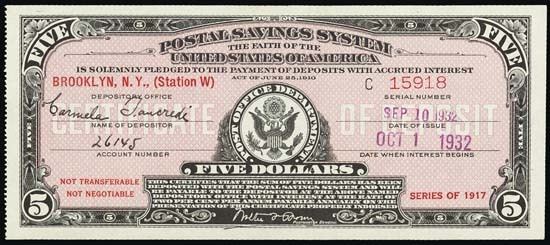 | ||
The United States Postal Savings System was a postal savings system signed into law by President William Howard Taft and was operated by the United States Post Office Department, predecessor of the United States Postal Service, from January 1, 1911 until July 1, 1967. The system paid depositors 2 percent annual interest. Depositors in the system were initially limited to hold a balance of $500, but this was raised to $1,000 in 1916 and to $2,500 in 1918. At its peak in 1947, the system held almost $3.4 billion in deposits. The system originally had a natural advantage over deposit-taking private banks because the deposits were always backed by "the full faith and credit of the United States Government." However, because the Federal Deposit Insurance Corporation gave the same guarantee to depositors in private banks, the Postal Savings System lost its natural advantage in trust.
From 1921, depositors were fingerprinted. This was initially 'not to be associated with criminology' but in some instances the Yours Truly, Johnny Dollar radio show in the early 1950s suggests Postal Savings account fingerprints were used for positive identification in criminal cases.
Locations
On March 26, 1911, the locations of the central depositories for the first 19 states were established, followed the next day by 25 others. The post offices were selected by merit rather than geography, based on those with the best efficiency record in the state.
